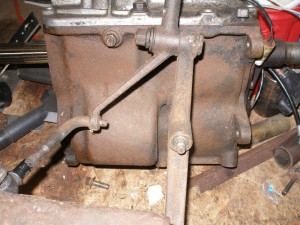By Tony K
 At first glance the shifter on our wagons is quite the contraption. What appears to be a single lever engages 4wd and moves between hi and low range. While it may seem to be simple, the lever doesn’t enter the t-case like the shifter on the tranny. The lever accomplishes all this with pivots and linkage. Moving the lever forward and aft shifts between 2 and 4wd and moving the lever left and right moves it in and out of low range.
At first glance the shifter on our wagons is quite the contraption. What appears to be a single lever engages 4wd and moves between hi and low range. While it may seem to be simple, the lever doesn’t enter the t-case like the shifter on the tranny. The lever accomplishes all this with pivots and linkage. Moving the lever forward and aft shifts between 2 and 4wd and moving the lever left and right moves it in and out of low range.
Any sloppiness will show it’s ugly head with a rattle. But any adjustments needed are easily accomplished with a couple of wrenches. But first you need to understand just how it works.
-The Contraption-
While the lever seems to be one piece it actually made up of three main parts. The main pivot arm (which is attached to the tranny), the lever that comes through the floor that pivots on the main arm and lastly the connecting rod that attaches to the lever on the top of the tranny that moves between hi and low. It’s easy to ID the parts in the pic even if it is hard to see them from underneath.
The pivot in the top of the pic is the lever through the floor. The one on the left is the hi/low connecting rod and the one at the bottom right (with the nut removed) is the main pivot arm that connects to the in/out shift rod of the t-case so you can engage 2 or 4wd.
 What has also been removed in the pics is a part that some people think is a brace. It is actually a component that prevents you from shifting into 2lo. Removing it has no effect on strength of the linkage or the normal operation of the t-case but now allows for the 2lo mod you may have heard about. The bracket in the pic has actually been modified for 2lo but removing it accomplishes the same thing. When I installed the H55 in my diesel this is just what I did.
What has also been removed in the pics is a part that some people think is a brace. It is actually a component that prevents you from shifting into 2lo. Removing it has no effect on strength of the linkage or the normal operation of the t-case but now allows for the 2lo mod you may have heard about. The bracket in the pic has actually been modified for 2lo but removing it accomplishes the same thing. When I installed the H55 in my diesel this is just what I did.
While the detent spring and ball assemblies that hold the gears of the t-case in position can be a factor, in and of themselves they are not likely to be the source of a rattle. Of the many t-cases I have had apart I have never found detents that weren’t working properly, not to say it doesn’t happen.
-Tightening Things Up-
The two main pivots are held in place with nuts and washers. What you also should find is a wavy or bent washer that is installed between the lockwasher and the lever itself. This bent washer allows you to apply some drag in the pivot itself. If the lever is free to move on its pivot the shaking of the motor or road vibrations will cause the lever to rattle. The bent washer is what allows you to fine tune just how much drag is applied to  the pivot point. In the pic you can see the nut, lockwasher, flat washer and right next to the shift lever, the aforementioned bent (or wavy) washer.
the pivot point. In the pic you can see the nut, lockwasher, flat washer and right next to the shift lever, the aforementioned bent (or wavy) washer.
What else you can’t see in the pics is the bushings that serve as bearings for the pivots. These should be in good shape with no looseness around there respective shafts. If they are loose, replace them.
You may notice that the hi/low connecting rod is only attached with a flat washer and cotter key. But it also has a bushing that needs to be checked. The other end of the connecting rod is attached with a ball joint that is not likely to rattle.
One thing to look for if your support bracket has been removed is looseness in the main pivot. Once that chunk of metal is removed you need to take up the space left with a washer of some sort to maintain the drag on the pivot. And remember that I am not saying it needs a lot of drag just enough to prevent the lever from easily pivoting on the shaft with no effort. It should take a light push to move the lever, it should not move on its own. There is a happy medium and its easily tightened or loosened with everything installed on your rig
So this should address a rattle in the lever. If it still makes noise or comes out of gear you may have more serious issues that require a closer look.

